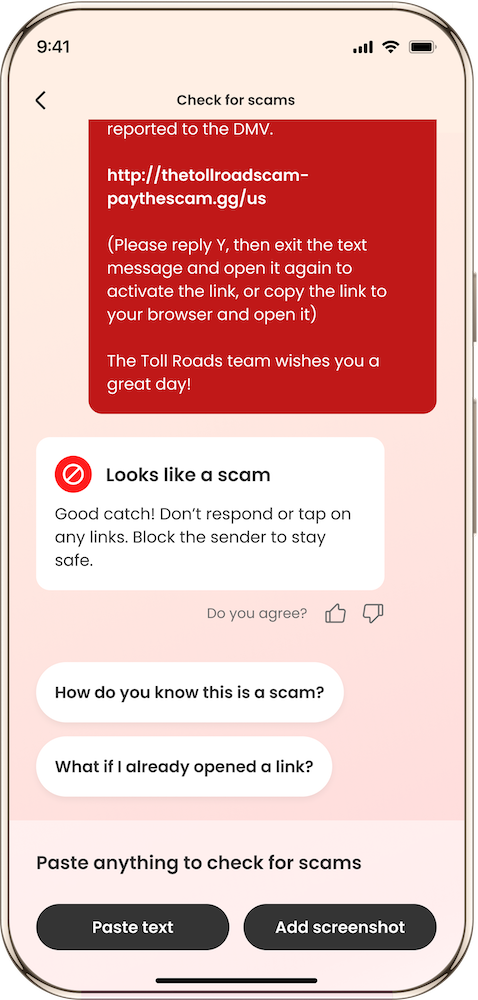
McAfee Total Protection has once again been named a TOP PRODUCT by the independent test lab AV-TEST, earning perfect scores in all three categories for the July–August 2025 test cycle.
This marks the 31st consecutive TOP PRODUCT certification for McAfee since June 2020, proof that our consumer protection consistently meets the highest independent standards.
While many security tools can slow your computer or trigger false alarms, McAfee keeps impact minimal and alerts meaningful, giving you reliable protection without getting in your way.

What the Scores Mean for You
Together, these results mean you’re getting lab-verified security that beats industry averages and stays ahead of major competitors, without sacrificing speed or ease of use.
You can read the full AV-TEST report here.
The post McAfee Again Certified as “TOP PRODUCT” by AV-TEST appeared first on McAfee Blog.

Was that spinning head a mistake—or the whole point?
When McAfee dropped a new digital ad showing a woman lounging on a beach, only to have her head rotate a full 360 degrees, the internet lit up. Some viewers thought it was a post-production error. Others assumed it was a weird deepfake gone wrong. And while a few sharp-eyed commentators caught the joke right away, most were left wondering: was this brilliant marketing or a complete fail?
Spoiler: it was on purpose.
You may have seen the ad—the calm beach scene, the casual vibe, and then, the fully rotating head. Reactions ranged from confused to amused, with a handful of keen observers nodding in understanding.
We didn’t mess up.
With the help of our creative agency VSA, we developed a series of digital ads using generative AI to blur the line between real and surreal. The goal? To make a bigger point: AI is now capable of mimicking reality in subtle, clever ways that are increasingly hard to detect. That’s exactly why tools like McAfee’s Scam Detector matter more than ever.
“While the ads are clearly AI, the implication is that AI isn’t always so easy to spot,” said Anne-Marie Rosser, CEO of VSA. “It’s funny, and it creates empathy for the user since we’re all susceptible.”
And don’t worry—we didn’t hand everything over to the machines. McAfee and VSA’s full creative and design teams were instrumental in shaping every detail, from concept to execution. The AI was a tool. The vision came from real people.
These creative choices reflect our philosophy at McAfee: take cybersecurity seriously, but don’t always take yourself too seriously. Humor has the power to break through fear and shame—and ultimately, help people protect themselves better.
Alongside these eye-catching ads, we’re launching Scam Stories, a social campaign built around real voices. From concert ticket scams to spoofed customer service texts, people across the country are sharing their experiences using #KeepItReal and #MyScamStory—and we’re listening.
Some of those individuals, like actor Chris Carmack (of Grey’s Anatomy and The O.C.), have joined our campaign to share their own moments of being duped. Others, like cyber student Henry or life coach Cory, are helping us educate others by turning personal pain into public empowerment.
This campaign isn’t just about awareness—it’s about action. That’s why we’ve partnered with FightCybercrime.org, a nonprofit that helps people recognize, report, and recover from scams. We’re donating $50,000 worth of McAfee protection to people in FightCybercrime programs and to the volunteers who support them.
We’re also teaming up to expand education efforts through our Online Safety for Kids initiative—because building a safer internet starts early.
Scammers rely on silence, shame, and speed. But when we slow down, speak up, and share our stories, we take away their power.
The Keep It Real campaign is more than just a product launch. It’s a movement to stop the stigma around scams, help people protect their peace of mind, and remind you: if it can happen to Chris Carmack, it can happen to anyone.
So what’s your scam story? We’re listening.
The post Keep It Real: How McAfee Is Using AI to Fight AI—and End Scam Stigma appeared first on McAfee Blog.

When Grey’s Anatomy actor Chris Carmack and musician Erin Slaver tried to order custom patio cushions from what seemed like a trustworthy small business, they thought they were making a simple home upgrade.
But after clicking and paying through a special link, the cushions never arrived. Delays turned into excuses, messages went unanswered, and the seller’s account eventually disappeared—along with their money.
It was a scam. And like so many others, they were left frustrated, embarrassed, and unsure of what to do next.
Now, Chris and Erin are sharing their story—not just to warn others, but to help launch Scam Stories, a McAfee-led movement to end the stigma around being scammed, remind people that it can happen to anyone, and help keep everyone safer online.
Scammers win when we stay silent. At McAfee, we believe speaking out about your experience is a brave way to support your community and help others stay safe from scams.
Built-in partnership with FightCybercrime.org, the Scam Stories movement invites people to share their scam experiences, end the stigma around being scammed, and build a more informed, supportive community.
And Chris and Erin aren’t the only ones speaking up. Our campaign features stories from everyday people who’ve been scammed—and are now helping others by sharing what happened.
These scams happened fast—and could happen to anyone. Each one involved tactics that McAfee Scam Detector is designed to catch:
These stories are powerful reminders that scam prevention starts with awareness. And when people share what happened, it helps others recognize red flags and feel less alone.
FightCybercrime.org is a nonprofit dedicated to helping people recognize, report, and recover from cybercrime. Their tools, educational materials, and survivor support network make them an ideal partner in our mission.
Together with FightCybercrime.org, we’ll be expanding online safety education —and helping more people recover from scams with real support.
As part of our collaboration, McAfee is donating $50,000 worth of protection products to individuals going through FightCybercrime.org’s recovery programs and to the staff and volunteers who support them every day.
At McAfee, we believe that scam protection isn’t just about tools—it’s about empowering people with knowledge and support. And that starts by ending the stigma.
Scam Stories is here to change the narrative—from shame to strength. With help from public figures like Chris and Erin, and brave individuals across the country, we’re turning painful moments into teachable ones—and helping everyone stay safer online.
McAfee is collecting scam stories and encouraging people to share their experiences on social media using #MyScamStory and #KeepItReal.
Learn more and join the movement at www.mcafee.com/en-us/scam-stories.
No one should feel alone or ashamed after being scammed. And the more we talk about scams, the harder it is for scammers to succeed.
Scam Stories is here to change the narrative—from shame to strength.
The post Introducing Scam Stories: A McAfee Campaign to End Scam Stigma appeared first on McAfee Blog.

Cory considers himself pretty cautious. But like millions of people juggling packed schedules, one click on a hectic day proved costly.
The message looked legit. It said it was from his phone provider. It claimed someone was trying to access his account and urged him to verify via a link. He tapped. And just like that, his phone went dark.
“I was in the middle of a busy day and clicked without thinking. My phone stopped working almost immediately.”
What Cory didn’t know was that the message wasn’t from his real cell company—it was from a scammer. The link gave them everything they needed to hijack his phone number.
In minutes, someone walked into a brick-and-mortar phone store, bought a new device, and ported Cory’s number to it. That gave them access to two-factor authentication codes, texts, and more.
“Suddenly I couldn’t call, text, or access anything that used my phone number. It was terrifying.”
As a life coach, Cory communicates with clients constantly—often by text. The idea that someone could impersonate him wasn’t just inconvenient. It was threatening.
“I’m a life coach—I talk to clients all day. The thought that someone could impersonate me or access those conversations was awful.”
He had to print out directions just to get to a Verizon store and spent nearly six hours recovering his phone number. Though he reset passwords in time to avoid deeper harm, billing issues lingered for months.
“It was one click. That’s all it took. I’ll never forget how fast it happened.”
SIM swap scams—like the one Cory experienced—are rising. The scary part? They often start with a single click. That’s where McAfee’s Scam Detector can make all the difference.
If Cory had access to McAfee’s Scam Detector, here’s how it could have helped:
Cory’s story is a powerful reminder: even careful people can get caught. The right protection gives you time to pause—and tools to act.
To stay ahead of similar scams, here are four critical tips:
1. Never click links in texts from unknown numbers.
Even if it looks like it’s from your phone carrier. Always verify through official apps or websites.
2. Turn on multi-factor authentication using an app—not just SMS.
Scammers target phone numbers for a reason. Authenticator apps like Google Authenticator or Duo offer stronger security.
3. Use McAfee’s Scam Detector for real-time protection.
Whether it’s a text, email, or link, McAfee can spot scam language and risky behavior before you’re compromised.
4. Report suspicious texts and lock down your account.
Call your carrier immediately if your service cuts off suddenly or you see suspicious account changes.

Cory’s quick click could have ended much worse. But what matters most is what happened after. He acted fast. He reset passwords. And now, he speaks out to help others recognize the signs.
“Slow down. Trust your gut. It’s okay to pause and double-check—even when you’re in a hurry.”
Scammers count on your rush. Slowing down—and having the right tools—can make all the difference.
If you’ve experienced a scam, your story can help others avoid the same fate. You’re not alone.
Visit our Scam Stories hub to read more scam stories or share your own.
The post Cory’s Scam Story: A Fake Text Nearly Took His Identity appeared first on McAfee Blog.

Brittany C., a dedicated teacher, had been planning a special night for months. After saving up steadily, she landed four prized tickets to Taylor Swift’s Eras Tour for her and her closest friends.
But days before the show, she logged into her account—and the tickets were gone.
“I’d been saving for months. I was so excited—and then I logged in and the tickets were just… gone. It felt like someone reached through the screen and took that night away from me.”
Like many of us, Brittany had received plenty of “your data was part of a breach” emails over the years. But she never expected what happened next.
A few days before the tickets disappeared, she had clicked on what she now realizes was a suspicious link. “I clicked one weird link. Nothing happened at the time, so I didn’t think twice,” she said. But that link was the scammer’s way in.
Using her reused password and without two-factor authentication on her account, the attacker was able to log in and transfer the tickets out—all without Brittany’s knowledge.
The emotional toll hit fast. “The stress was overwhelming,” she says. “Friends had made travel plans, taken time off. I felt like I’d let everyone down.”
After a long back and forth with the online ticket sales platform, Brittany managed to recover the tickets. But the damage was done. The experience reshaped how she thinks about online safety.
“You can be careful and still get caught. I’m only human—and that’s exactly what scammers count on.”
Brittany’s experience is a textbook example of how a small slip can spiral into a high-stakes scam. McAfee’s Scam Detector is designed to catch those mistakes before they snowball.
If she had McAfee’s Scam Detector, here’s how it could have helped:
With Scam Detector watching her back, Brittany could have known that the link was dangerous before clicking—and avoided the gut-wrenching scramble to reclaim her tickets.
Here are four essential tips to help protect your digital accounts and event tickets:
1. Never reuse passwords.
Use a password manager to create strong, unique passwords for each account—especially ticketing and banking platforms.
2. Always turn on two-factor authentication.
It’s one of the easiest ways to block unauthorized logins—even if someone has your password.
3. Think before you click.
If a message or link seems off, don’t open it. Use McAfee’s Quick Check to scan suspicious links before interacting.
4. Use scam detection software for extra protection.
Tools like McAfee’s Scam Detector offer real-time alerts and background scanning to help prevent phishing, credential theft, and social engineering attacks.
Scams can happen to anyone—even people who do everything right. Brittany’s story is a reminder that vigilance matters, but so does visibility.
By telling your story, you’re helping others spot the signs of scams and take steps to protect themselves.
At McAfee, we believe there’s no shame in being scammed—only power in sharing.
Visit our scam stories hub to read more real scam stories or share your own to help end scam stigma.
The post Brittany’s Scam Story: Eras Tour Chaos appeared first on McAfee Blog.

Henry A. had been trying for weeks to score a ticket to see Tyler, the Creator in Dallas. Even without a confirmed seat, he headed to the venue hoping for a miracle. And that’s when the message came in—someone nearby claimed to have extra tickets.
The seller said he was just outside too. The price? Reasonable enough. The tone? Casual and confident. All Henry had to do was send half the money to hold the tickets.
Minutes later, he sent the full $280.
“I was already in line—excited, hopeful, and just trying to get in. That made me an easy target.”
At first, the offer felt legitimate. The seller even said his girlfriend was wary of strangers, which seemed believable. But after Henry sent the full amount, the conversation took a turn.
“He said his girlfriend didn’t trust me, then suddenly wanted full payment. Then it was someone else offering more. That’s when I knew.”
The seller began stalling. Then came a screenshot—another buyer offering a higher price. He pressured Henry to pay more. When Henry refused, the seller blocked him.
Just like that, the tickets were gone. So was the money. And Henry and his friend never made it into the show.
“I sent $280 and got blocked. We never made it inside.”
It wasn’t just the lost money—it was the emotional rollercoaster. The disappointment. The feeling of being tricked right at the door.
Scams like Henry’s are becoming more common—especially around live events. That’s why McAfee’s Scam Detector is built to flag shady behavior before it costs you.
If Henry had been using McAfee’s Scam Detector, here’s how it could’ve helped:
“If I’d had something flagging the account or even the language in the messages, it might’ve stopped me in time.”
Want to protect yourself from last-minute ticket scams? Follow these smart tips:
1. Don’t pay up front without protection.
Always use secure payment methods that offer fraud protection—never cash apps or peer-to-peer services for strangers.
2. Use scam detection tools before sending money.
Paste messages or links into McAfee’s Quick Check to analyze them for red flags.
3. Watch for changing terms or pressure tactics.
If someone shifts the deal mid-conversation, it’s a red flag. Real sellers don’t change the price last minute or ask for more money after payment.
4. Trust your instincts—and the tech.
Scammers rely on urgency and excitement. Having McAfee Scam Detector on your phone adds a digital gut check when your real one is clouded.

Henry is already spreading the word on social media, warning other fans about concert scams. Now we’re helping amplify his voice—because awareness is one of the most powerful forms of protection.
“I’m already trying to warn others on social media. Concert scams are real—and they’re getting more common.”
Have a scam story of your own? Don’t keep it to yourself. By sharing what happened, you can help someone else avoid the same fate.
Visit our scam stories hub to read more or share your experience. Together, we can end scam stigma and stop scammers in their tracks.
The post Henry’s Scam Story: The Social Media Con appeared first on McAfee Blog.

Bradley K. was a brand-new dad, sleep-deprived and juggling life with a newborn, when he received a phone call that would change everything. The caller claimed to be from the IRS and said Bradley owed back taxes. If he didn’t pay immediately, they warned, he could be arrested.
Unfortunately, it was a tax scam—and one that cost him $800 and left him shaken for months.
Like many Americans, Bradley had just filed his taxes. When the call came through, it seemed believable. The caller knew personal information, spoke with a local accent, and used aggressive tactics to demand fast action.
“I had just filed my taxes, so when they told me there was a problem, it didn’t seem completely far-fetched.”
Under pressure and running on little sleep, Bradley didn’t stop to verify. He didn’t call his dad—who also happened to be his accountant. Instead, he sent $800 and unknowingly gave scammers access to his bank account.
“I was running on barely any sleep with a newborn, and I wasn’t thinking as clearly as I normally would have.”
It wasn’t until days later that a friend told him the truth: the IRS never calls demanding immediate payment. By then, it was too late. The money was gone, and Bradley was left feeling embarrassed and anxious.
“Even now, almost a year later, I’m constantly on edge, making sure nothing else has been stolen.”
Bradley’s experience is exactly why we created McAfee’s Scam Detector—a smart, AI-powered tool that identifies scams across email, text, and even video.
If Bradley had received a scam follow-up message or email while using McAfee’s Scam Detector, the tool could have flagged it automatically—before he ever opened it. He could have also used the Quick Check feature to paste in the message or phone transcript and receive an instant scam analysis.
Key features that could have protected Bradley:
Best of all? McAfee’s Scam Detector is included at no extra cost with McAfee core plans.

Here’s how to avoid tax scams like the one that targeted Bradley:
1) Know the IRS will never call you to demand payment.
If someone says you owe money and threatens arrest, it’s a scam. The IRS contacts people by mail first.
2) Use McAfee’s Scam Detector for real-time protection.
Scan any suspicious email, text, or message using Quick Check before clicking or responding.
3) Always take a pause before acting.
Scammers rely on urgency. Take a breath, verify the claim independently, and talk to someone you trust.
4) Keep scam protection up to date.
Enable scam alerts across your devices to stay one step ahead. McAfee Scam Detector works across smartphones, laptops, and tablets.
Bradley’s story is just one of thousands. But too often, people stay silent out of shame or embarrassment. That silence helps scammers win.
At McAfee, we believe in highlighting real scam stories—not to scare people but to empower them. These aren’t victims. They’re survivors.
Have a story of your own? You’re not alone—and your experience could help someone else.
Visit our Scam Stories Hub to share your story and help stop scams in their tracks.
The post Bradley’s Scam Story: New Dad vs Fake IRS Call appeared first on McAfee Blog.